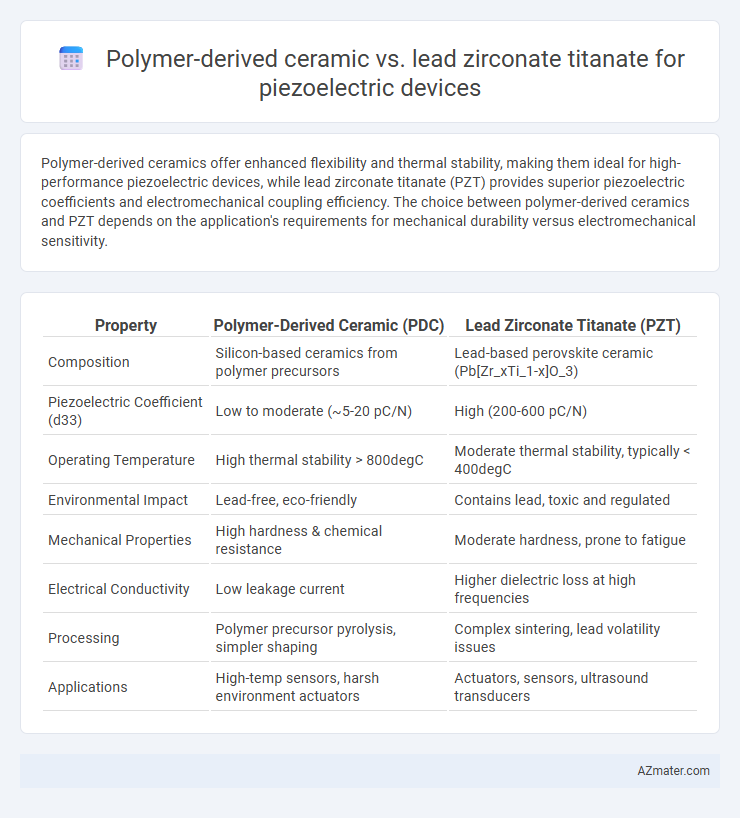Polymer-derived ceramics offer enhanced flexibility and thermal stability, making them ideal for high-performance piezoelectric devices, while lead zirconate titanate (PZT) provides superior piezoelectric coefficients and electromechanical coupling efficiency. The choice between polymer-derived ceramics and PZT depends on the application's requirements for mechanical durability versus electromechanical sensitivity.
Table of Comparison
| Property | Polymer-Derived Ceramic (PDC) | Lead Zirconate Titanate (PZT) |
|---|---|---|
| Composition | Silicon-based ceramics from polymer precursors | Lead-based perovskite ceramic (Pb[Zr_xTi_1-x]O_3) |
| Piezoelectric Coefficient (d33) | Low to moderate (~5-20 pC/N) | High (200-600 pC/N) |
| Operating Temperature | High thermal stability > 800degC | Moderate thermal stability, typically < 400degC |
| Environmental Impact | Lead-free, eco-friendly | Contains lead, toxic and regulated |
| Mechanical Properties | High hardness & chemical resistance | Moderate hardness, prone to fatigue |
| Electrical Conductivity | Low leakage current | Higher dielectric loss at high frequencies |
| Processing | Polymer precursor pyrolysis, simpler shaping | Complex sintering, lead volatility issues |
| Applications | High-temp sensors, harsh environment actuators | Actuators, sensors, ultrasound transducers |
Overview of Piezoelectric Devices
Polymer-derived ceramics (PDCs) offer enhanced thermal stability and mechanical flexibility compared to conventional Lead Zirconate Titanate (PZT) in piezoelectric devices, enabling broader application in harsh environments. PZT remains the industry standard due to its high piezoelectric coefficients and excellent electromechanical coupling, providing superior sensitivity and energy conversion efficiency. Advances in PDC technology focus on optimizing microstructure and electrical properties to rival PZT performance while maintaining eco-friendly and lead-free benefits.
Fundamentals of Polymer-Derived Ceramics
Polymer-derived ceramics (PDCs) are synthesized through the controlled pyrolysis of preceramic polymers, resulting in amorphous or nanocrystalline ceramic materials with outstanding thermal stability, chemical resistance, and customizable microstructures. Unlike lead zirconate titanate (PZT), which is a conventional perovskite ceramic with high piezoelectric coefficients but limited by lead content and brittleness, PDCs offer flexible processing routes and the ability to engineer composition and phase at the molecular level. The fundamental advantage of PDCs lies in their tunable ceramic phases, enabling the design of lead-free, lightweight piezoelectric devices with enhanced durability and environmental compatibility.
Introduction to Lead Zirconate Titanate (PZT)
Lead zirconate titanate (PZT) is a widely used piezoelectric material known for its high piezoelectric coefficients, excellent ferroelectric properties, and strong electromechanical coupling, making it a preferred choice in sensors, actuators, and transducers. Its perovskite crystal structure allows for easy polarization switching, which contributes to its superior piezoelectric response compared to polymer-derived ceramics. Despite advantages in flexibility and thermal stability offered by polymer-derived ceramics, PZT's high sensitivity and efficiency continue to dominate piezoelectric device applications.
Material Properties: Structural Comparison
Polymer-derived ceramics exhibit an amorphous to nanocrystalline microstructure that provides enhanced flexibility and thermal stability compared to the highly crystalline perovskite structure of lead zirconate titanate (PZT), which offers superior piezoelectric coefficients due to its well-ordered lattice. The intrinsic porosity and tunable composition in polymer-derived ceramics enable controlled dielectric and mechanical properties, whereas PZT's dense ceramic matrix results in higher polarization and electromechanical coupling efficiency. Structural differences influence device performance, with PZT favored for high-sensitivity applications and polymer-derived ceramics preferred in environments requiring mechanical resilience and thermal shock resistance.
Piezoelectric Performance: Output and Sensitivity
Polymer-derived ceramics exhibit moderate piezoelectric output with enhanced sensitivity due to their flexible microstructure and tunable composition, making them suitable for low-power sensing applications. Lead zirconate titanate (PZT) outperforms polymer-derived ceramics in piezoelectric output with higher electromechanical coupling coefficients and superior sensitivity, driven by its well-established perovskite crystal structure. The output voltage and charge generation in PZT-based devices typically exceed that of polymer-derived ceramics, resulting in greater efficiency for high-precision piezoelectric sensors and actuators.
Fabrication Techniques and Scalability
Polymer-derived ceramics (PDCs) utilize pyrolysis of preceramic polymers allowing low-temperature processing and enabling complex geometries unattainable with traditional ceramic sintering used in lead zirconate titanate (PZT) fabrication. PZT is typically produced through conventional solid-state reaction or sol-gel methods, which require high temperatures and limit microstructural control, impacting scalability and device miniaturization. The polymer-derived approach offers enhanced scalability for flexible and micro-scale piezoelectric devices, while PZT remains dominant for high-performance bulk applications due to established industrial protocols.
Mechanical Flexibility and Durability
Polymer-derived ceramics exhibit enhanced mechanical flexibility compared to Lead Zirconate Titanate (PZT), enabling their use in bendable and wearable piezoelectric devices. While PZT offers higher piezoelectric coefficients, its brittleness limits durability under mechanical strain, whereas polymer-derived ceramics maintain structural integrity through inherent toughness and resistance to fatigue. This combination of flexibility and durability makes polymer-derived ceramics increasingly suitable for applications demanding repeated mechanical deformation and long-term reliability.
Environmental Impact and Toxicity
Polymer-derived ceramics (PDCs) offer a significant environmental advantage over lead zirconate titanate (PZT) due to their lead-free composition, reducing heavy metal pollution and toxicity concerns. PZT, containing lead, poses serious environmental hazards during manufacturing, disposal, and recycling, contributing to soil and water contamination. The use of PDCs aligns with sustainable development goals by minimizing hazardous waste and supporting eco-friendly piezoelectric device applications.
Application Suitability and Limitations
Polymer-derived ceramics (PDCs) offer enhanced thermal stability and chemical resistance, making them suitable for high-temperature and harsh environment piezoelectric applications where lead zirconate titanate (PZT) may degrade. Lead zirconate titanate exhibits superior piezoelectric coefficients and electromechanical coupling, ideal for precise sensing and actuating devices requiring high sensitivity and efficiency. Limitations of PDCs include lower piezoelectric performance compared to PZT, while PZT's lead content raises environmental and health concerns, restricting its use in eco-sensitive applications.
Future Prospects and Research Directions
Polymer-derived ceramics (PDCs) offer promising future prospects in piezoelectric devices due to their tunable microstructures, high thermal stability, and potential for flexible, lightweight applications compared to conventional lead zirconate titanate (PZT). Research is increasingly focused on enhancing the electro-mechanical coupling efficiency and environmental sustainability of PDCs by optimizing polymer precursors and pyrolysis processes. Emerging studies are also exploring integrating PDCs with nanocomposites to overcome PZT limitations such as lead toxicity and brittleness, paving the way for next-generation wearable and biomedical piezoelectric systems.

Infographic: Polymer-derived ceramic vs Lead zirconate titanate for Piezoelectric device
 azmater.com
azmater.com